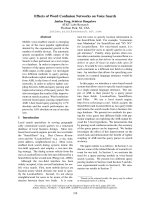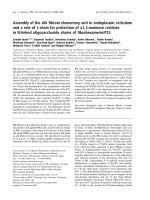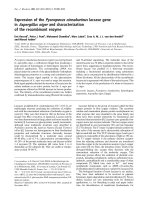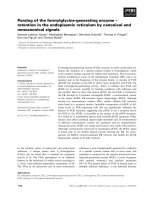Báo cáo khoa học: "Effects of sustained subculture on apparent rejuvenation of the apple rootstock M.9 in vitro and in vivo" pps
Bạn đang xem bản rút gọn của tài liệu. Xem và tải ngay bản đầy đủ của tài liệu tại đây (140.71 KB, 3 trang )
Effects
of
sustained
subculture
on
apparent
rejuvenation
of
the
apple
rootstock
M.9
in
vitro
and
in
vivo
C.A.
Webster
O.P.
Jones
Institute
of
Horticultural
Research,
East
Malling,
Maidstone,
Kent,
U.K.
Introduction
proliferation
medium
containing
2
mgll
BAP
Introduction
Sequential
subculture
of
fruit
trees
leads
to
a
gradual
physiological
change
which
may
be
termed
’rejuvenation’.
This
change
is
characterized
by
a
gradual
improvement
in
shoot
production
and
rooting
in
vitro
(Jones,
1985).
Hedges
established
from
micropropa-
gated
plants
of
the
plum
rootstock
Pixy
(Prunus
insititia)
continued
for
at
least
9
yr
to
produce
shoot
cuttings
with
the
juvenile
character
of
more
rapid
rooting
(Howard
et
al.,
1989a).
Thus,
rejuvenation
as
a
result
of
micropropagation
may
be
ex-
ploited
to
improve
conventional
propa-
gation
of
clones
which
are
normally
dif-
ficult
to
propagate.
This
paper
describes
the
apparent
reju-
venation
in
vitro
of
the
apple
rootstock
M.9
and
the
subsequent
retention
of
juvenile
characters
in
micropropagated
plants
in
the
field.
M.9
is
one
of
the
most
frequently
used
apple
rootstocks
worldwide
but
suf-
fers
from
the
serious
shortcoming
of
being
difficult
to
propagate.
Materials
and
Methods
Two
shoot
culture
lines,
A
and
B,
were
esta-
blished
in
1986
from
2
shoot
tip
explants
on
MS
proliferation
medium
containing
2
mgll
BAP
(benzylaminopurine),
0.1
mg/I
IBA
(indole
buty-
ric
acid)
and 162
mgli
phloroglucinol
(PG).
These
2
culture
lines
were
subcultured
monthly
for
21
mo
along
with
2
other
culture
lines
initi-
ated
in
1978
and
1982,
respectively.
In
vitro
rooting
involved
transfer
for
4
d
of
single
shoots
from
proliferation
medium
to
MS
medium
containing
3
mg/l
IBA,
followed
by
transfer
for
3
wk
to
half-strength
MS
medium
without
growth
regulators.
Direct
rooting
involved
transfer
of
single
shoots
from
proliferation
medium,
dipped
in
a
powder
preparation
of
0.2%
IBA
+ 10%
Captan,
to
sterile
horticultural
sand
for
4
wk
(Webster
and
Jones,
1989).
Micropropagated
plants
produced
in
1985
from
culture
lines
initiated
in
1978
and
1982
were
grown
in
the
glasshouse
during
1986
and
transferred
to
the
field
in
1987
as
hedge
plants.
Rooting
of
leafy
summer
cuttings
and
leafless
winter
cuttings
from
these
micropropagated
plants
was
evaluated
during
1986-1988
in
com-
parison
with
cuttings
from
conventionally
propa-
gated
plants.
Results
Apparent
rejuvenation
in
vitro
Shoot
production
with
the
two
1986
cul-
ture
lines
increased
from
a
mean
of
1
new
shoot
per
single
shoot
inoculum
to
around
5
new
shoots
with
monthly
subculture
over
21
mo.
Shoot
production
of
culture
line
B
remained
significantly
higher
(P<0.001)
than
that
of
culture
line
A.
Mean
shoot
production
was
greatest
at
7
new
shoots
per
inoculum
with
the
5
and
9
yr
old
cul-
ture
lines
but
there
was
no
significant
dif-
ference
between
them.
In
vitro
rooting
of
the
two
1986
culture
lines
increased
from
a
mean
of
12 ±
7.8%
after
5
mo
on
proliferation
medium
to
a
maximum
of
73
±
8.1 %
after
12
mo.
Root-
ing
of
culture
line
B
was
significantly
higher
(P <0.01 )
than
that of
line
A
with
a
maximum
of
93
±
6.4%
rooted
shoots
achieved
by
culture
line
B
but
only
69
±
11.6%
achieved
by
culture
line
A.
Rooting
was
consistently
high
at
around
90%
with
the
1982
and
1978
culture
lines,
but
there
was
no
significant
difference
between
them.
The
presence
of
phloroglucinol
in
the
proliferation
medium
improved
sub-
sequent
rooting
at
the
11th
and
l5th
sub-
cultures
but
not
at
the
21 st
subculture.
Establishment
of
plantlets
in
compost
was
low
following
in
vitro
rooting
but
was
increased
significantly
(P<0.001)
when
shoots
from
proliferation
medium
were
rooted
directly
into
sand.
Apparent
rejuvenation
in
vivo
When
micropropagated
plants
from
1978
and
1982
culture
lines
were
grown
as
field
hedges,
they
produced
more
than
twice
as
many
shoots
in
the
first
year
as
conven-
tional
hedges
from
rooted
stoolbed
shoots.
Rooting
was
consistently
greater
in
summer
and
winter
cuttings
from
micro-
propagated
plants
than
in
cuttings
from
conventional
hedges.
In
summer
1988,
rooting
from
the
micropropagated
plants
was
further
improved
by
severely
pruning
the
stock
plants
to
give
the
maximum
of
57 ±
8.9%
in
the
1978
source
over
a
4
wk
period
as
compared
with
3
±
3.3%
from
the
severely
pruned
conventional
source.
Discussion
and
Conclusions
Monthly
subculture
of
M.9
appeared
to
induce
’rejuvenation’
which
was
ex-
pressed
as
improved
shoot
production
and
rooting
in
vitro
and
subsequently
of
micropropagated
plants
in
the
field.
Similar
increased
rooting
ability
of
cuttings
from
micropropagated
stockplants
of
the
plum
rootstock
Pixy
has
been
sustained
for
at
least
9
yr
(Howard
et
aL,
1989a).
Differences
in
shoot
production
and
root-
ing
of
M.9
in
vitro
also
appeared
to
origi-
nate
from
differences
between
explants
used
to
initiate
culture
lines.
Decreasing
dependence
with
subculture
on
phloroglucinol
(PG)
for
rooting
sug-
gests
that
phenolic
metabolism
may
be
involved
in
rejuvenation.
This
view
is
also
supported
by
the
observation
that
PG
in
the
culture
medium
improved
poor
in
vitro
growth
of
shoot
tip
explants
for
conven-
tional
plants
of
the
plum
rootstock
Pixy,
but
had
no
effect
on
explants
from
puta-
tively
rejuvenated
micropropagated
plants
(Howard
et al.,
1989b).
Acknowledgments
We
wish
to
thank
the
Agricultural
Genetics
Company
for
contributing
to
the
funding
of
this
work.
References
Howard
B.H.,
Jones
O.P.
&
Vasek
J.
(1989a)
Long-term
improvement
in
the
rooting
of
plum
cuttings
following
apparent
rejuvenation.
J.
Hortic.
Sci. 64, 147-156
Howard
B.H.,
Jones
O.P.
&
Vasek
J.
(1989b)
Growth
characteristics
of
apparently
rejuve-
nated
plum
shoots.
J.
Hortic.
Sci.
64, 157-162
Jones
O.P.
(1985)
The
role
of
growth
regulators
in
the
propagation
in
vitro
of
temperate
fruit
trees.
In:
Growth
Regulators
in
Horticulture
(Menhenett
R.,
ed.).
British
Plant
Growth
Regu-
lator
Group
Monograph
13,
pp.
113-124
Webster
C.A.
&
Jones
O.P.
(1989)
Micropropa-
gation
of
the
apple
rootstock
M.9:
effect
of
sus-
tained
subculture
on
apparent
rejuvenation
in
vitro.
J.
Hortic.
Sci.
64,
421-428









